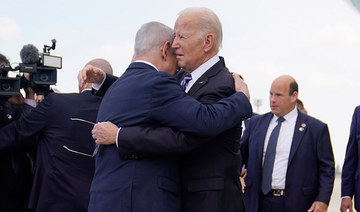LONDON: A US State Department official has resigned in protest at what he called the Biden administration’s “intellectual bankruptcy” in supplying further weapons and ammunition to Israel, The Guardian reported on Thursday.
Israeli bombings have killed more than 3,700 people in Gaza, while nearly 12,500 others have been wounded, in retaliation for an Oct. 7 attack on Israel by Hamas militants.
Josh Paul, the director of congressional and public affairs for the State Department’s Bureau of Political-Military Affairs, said on Wednesday in a letter posted on LinkedIn that the government “rushing” to provide arms to Israel was “shortsighted, destructive, unjust, and contradictory to the very values that we publicly espouse.”
His resignation came a day after an Israeli airstrike on Al-Ahli Al-Arabi Hospital in the Gaza Strip killed hundreds of people, many of whom were children.
“But I believe to the core of my soul that the response Israel is taking, and with it the American support both for that response and for the status quo of the occupation, will only lead to more and deeper suffering for both the Israeli and the Palestinian people,” he wrote.
“This administration’s response — and much of Congress’s as well — is an impulsive reaction built on confirmation bias, political convenience, intellectual bankruptcy, and bureaucratic inertia.”
The New York Times reported that Biden planned to ask Congress for $10 billion in “mostly military assistance” for Israel.
Paul characterized the Bureau of Political-Military Affairs as “the US government entity most responsible for the transfer and provision of arms to partners and allies.”
He said that in his 11 years at the bureau, he had “made more moral compromises than I can recall.”
Paul wrote: “I knew (the role) was not without its moral complexity and moral compromises, and I made myself a promise that I would stay for as long as I felt the harm I might do could be outweighed by the good I could do. I am leaving today because I believe that in our current course with regards to the continued — indeed, expanded and expedited — provision of lethal arms to Israel, I have reached the end of that bargain.”

























